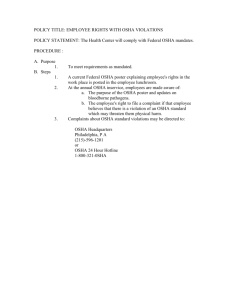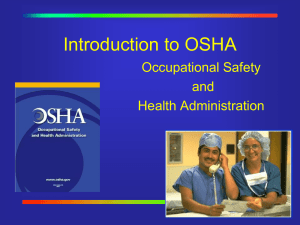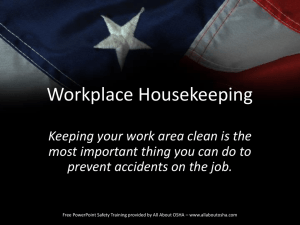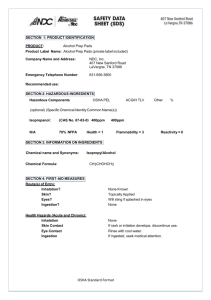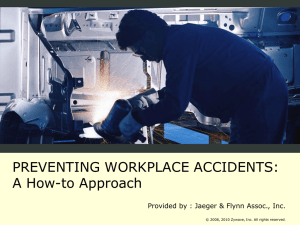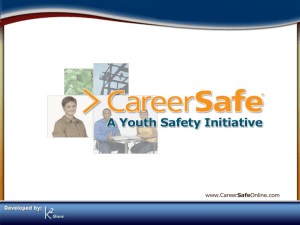CHAPTER 13 Instructor Manual
advertisement
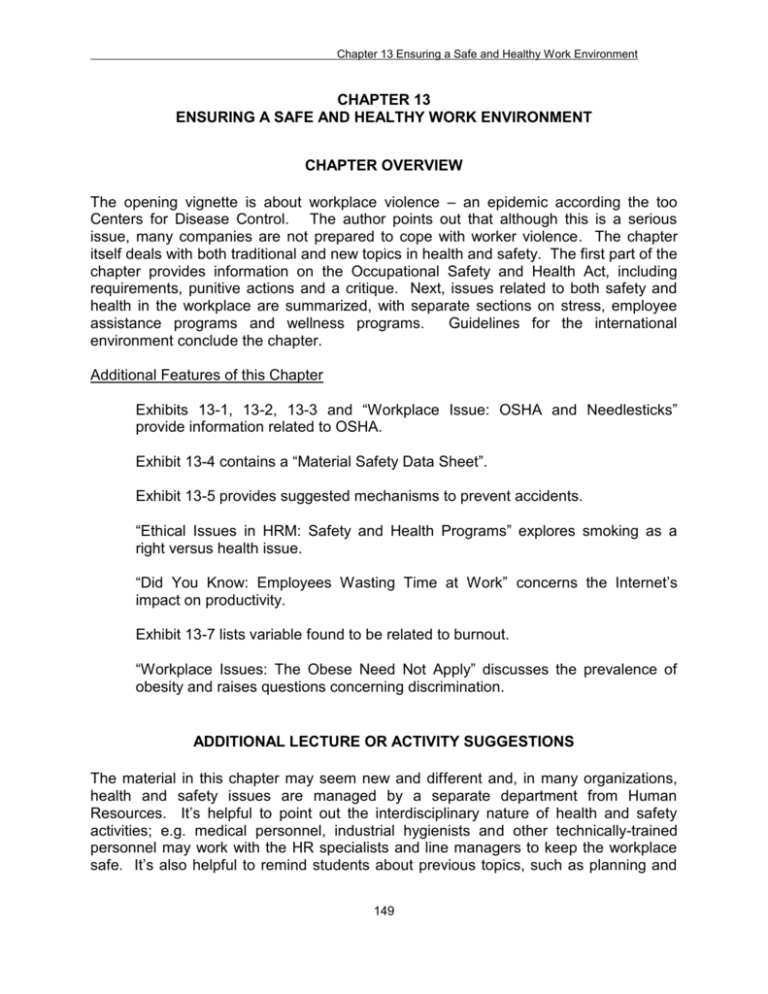
Chapter 13 Ensuring a Safe and Healthy Work Environment CHAPTER 13 ENSURING A SAFE AND HEALTHY WORK ENVIRONMENT CHAPTER OVERVIEW The opening vignette is about workplace violence – an epidemic according the too Centers for Disease Control. The author points out that although this is a serious issue, many companies are not prepared to cope with worker violence. The chapter itself deals with both traditional and new topics in health and safety. The first part of the chapter provides information on the Occupational Safety and Health Act, including requirements, punitive actions and a critique. Next, issues related to both safety and health in the workplace are summarized, with separate sections on stress, employee assistance programs and wellness programs. Guidelines for the international environment conclude the chapter. Additional Features of this Chapter Exhibits 13-1, 13-2, 13-3 and “Workplace Issue: OSHA and Needlesticks” provide information related to OSHA. Exhibit 13-4 contains a “Material Safety Data Sheet”. Exhibit 13-5 provides suggested mechanisms to prevent accidents. “Ethical Issues in HRM: Safety and Health Programs” explores smoking as a right versus health issue. “Did You Know: Employees Wasting Time at Work” concerns the Internet’s impact on productivity. Exhibit 13-7 lists variable found to be related to burnout. “Workplace Issues: The Obese Need Not Apply” discusses the prevalence of obesity and raises questions concerning discrimination. ADDITIONAL LECTURE OR ACTIVITY SUGGESTIONS The material in this chapter may seem new and different and, in many organizations, health and safety issues are managed by a separate department from Human Resources. It’s helpful to point out the interdisciplinary nature of health and safety activities; e.g. medical personnel, industrial hygienists and other technically-trained personnel may work with the HR specialists and line managers to keep the workplace safe. It’s also helpful to remind students about previous topics, such as planning and 149 Chapter 13 Ensuring a Safe and Healthy Work Environment job design which are very relevant to the successful design and implementation of health and safety programs. Students often have good examples from their own work experiences of unhealthy or unsafe employment conditions. For each example, discuss the employer’s and employee’s responsibilities, as well as suggestions for making the workplace healthier. Always bring up the question of how much it would cost to implement a suggestion, and whether the benefits would justify the cost to the employer. CHAPTER OUTLINE AND LECTURE SUGGESTIONS I. Introduction A. Management has both legal and moral responsibilities to provide a safe and healthy workplace. B. Work-related accidents, injuries, and illnesses are costly. II. The Occupational Safety and Health Act (OSHA) A. 1970 Federal legislation 1. Established health and safety standards. 2. Authorized inspections and fines for violations. 3. Empowered OSH Administration to ensure standards are met. 4. Requires employers to keep records of illnesses and injuries, and calculate accident ratios. 5. Applies to almost every U.S. business engaged in interstate commerce. B. OSHA Enforcement Priorities 1. Imminent danger: Where an accident is about to occur. 2. Accidents that have led to serious injuries or death. Employer must report within 8 hours. 3. Employee complaints: Employees have right to call OSHA. 4. Inspection of industries with the highest injury or illness rates: chemical processing, roofing and sheet metal, meat processing, lumber and wood products, mobile homes and campers, stevedoring. Additionally, special emphasis is placed on the handling of hazardous waste. 5. Random inspection: Supreme Court ruled (Marshall v. Barlow’s Inc., 1978) that employers are not required to let OSHA inspectors enter without search warrants. Most attorneys recommend companies cooperate with inspectors. C. OSHA’s Record-Keeping Requirements 1. Basis for record-keeping is Form 300 (See Figure 13-2). 2. Must report any work-related illness; report injuries that require medical treatment besides first aid, involve loss of consciousness, restriction of work 150 Chapter 13 Ensuring a Safe and Healthy Work Environment or motion, or transfer to another job. See decision-making schematic, Figure 13-3. 3. Incidence rate: Number of illnesses, injuries or lost workdays per 100 fulltime workers. D. OSHA Punitive Actions 1. Omnibus Budget Reconciliation Act of 1990 allows fines up to $70,000 if violation is severe, willful and repetitive. 2. Fines can be for safety violations or failure to keep adequate records. 3. Courts have backed criminal charges against executives when they have willfully violated health and safety laws. E. OSHA: A Critique 1. OSHA has made organizations more aware of health and safety. 2. National Institute for Occupational Safety and Health (NIOSH) has been researching and setting standards for new areas; i.e. blood-borne pathogens, chemical process safety, motor vehicle safety, protective equipment, and ergonomics. 3. Hazard Communication Standard, (1983), requires organizations to communicate information about hazardous chemicals on the job by labeling containers, distributing data sheets, and training employees in their safe handling. 4. Since 9/11 has provided assistance on contingency planning to deal with emergencies. III. Job Safety Programs A. Costs of Accidents 1. Workers’ compensation premiums. 2. Time lost due to injury. 3. Time to investigate/report accidents. 4. Damage to equipment/materials. 5. Work stoppages/personnel changeover. B. Causes of Accidents: Accidents are generally classified as human or environmental. 1. Human causes responsible for majority of accidents. 2. Environmental causes include tools, equipment, physical plant, general work environment. 151 Chapter 13 Ensuring a Safe and Healthy Work Environment C. Preventative Measures: Summarized in Table 13-5. 1. Education 2. Skill training 3. Engineering 4. Protection devices 5. Regulation enforcement. D. Ensuring Job Safety 1. Management needs feedback from inspections, reports, and observations. 2. Safety should be part of organizational culture. 3. Top management must be committed to safety. 4. Safety committees empower employees to maintain a safe environment. E. A Safety Issue: Workplace Violence. 1. Homicide is in the top three causes of work-related deaths in the USA. Two significant contributing factors: a. Domestic violence b. Disgruntled employees 2. Recommended HRM actions: a. Develop a plan, including review of policies and employee treatment. b. Train supervisory personnel to identify and deal with troubled employees. c. Implement stronger security mechanisms. d. Prepare employees to deal with violent situations. IV. Maintaining a Healthy Work Environment A. Sick buildings are office environments that contain harmful airborne chemicals, asbestos, or indoor pollution. Suggestions for keeping the environment healthy include: 1. Making sure workers get enough fresh air. 2. Avoiding suspect building materials and furnishings. 3. Testing new buildings for toxins before occupancy. 4. Providing a smoke-free environment. 5. Keeping air ducts clean and dry. 6. Paying attention to workers’ complaints. B. The Smoke-Free Environment 1. Costs of smokers include increased health premiums, absenteeism, lost productivity due to smoke breaks, maintenance costs, harm to coworkers by second-hand smoke. 2. Smoke-free policies at work include banning smoking or restricting it to properly ventilated designated areas. 3. Employees should be involved in phase-in of programs. 4. Some employers offer incentives and help for employees to stop smoking. 152 Chapter 13 Ensuring a Safe and Healthy Work Environment C. Repetitive Stress Injuries 1. Also referred to as musculoskeletal disorders (MSDs). Injuries resulting from continuous, repetitive movements, such as typing. The most frequent injury is carpal tunnel syndrome, which occurs in the wrist. 2. Ergonomics, or fitting the work environment to the individual, can prevent repetitive motion injuries. Includes design of environment and furniture to fit the individual. V. Defining Stress A. Definition 1. Dynamic condition in which an individual is confronted with opportunity, constraint or demand related to what he or she desires for which outcome is uncertain and important. 2. May be caused by either positive factors (opportunities) or negative. 3. The Japanese concept of karoshi, death from overworking, illustrates the pervasive nature of stress. B. Common Causes of Stress - Stress can be grouped into two major categories: organizational and personal. 1. Organizational Factors a. Task demands include job design, working conditions, the physical layout, and work quotas. b. Role demands include role conflicts, role overload and role ambiguity. c. Interpersonal demands include lack of social support and poor interpersonal relationships. d. Organizational structure causes include excessive rules and lack of opportunity to participate. e. Organizational leadership causes include supervisory styles which cause unrealistic pressures, tight controls, and the threat of job loss. 2. Personal Factors a. Family issues b. Personal economic problems c. Inherent personality characteristics: Some individuals may have a tendency to accentuate negative aspects of life. Type A employees are more likely to show symptoms of stress and typically have a chronic sense of time urgency and excessive competitive drive. C. Symptoms of Stress 1. Physiological symptoms (increased blood pressure, headaches, increased pulse rate, etc.) are the most difficult to observe. 2. Psychological symptoms (increased tension and anxiety, boredom, procrastination, etc.) can lead to productivity decreases. 3. Behavioral symptoms (increased smoking or substance consumption, sleep disorders, etc.) also affect the organization. 153 Chapter 13 Ensuring a Safe and Healthy Work Environment D. Reducing Stress – HRM’s Role 1. HRM approaches include matching individuals to their jobs, clarifying expectations, redesigning jobs, and offering involvement and participation. 2. Dilemmas for HRM include balancing the need to energize people with the need to minimize dysfunctional stress, and deciding how much an employer can intrude on employees’ personal lives. E. A Special Case of Stress: Burnout 1. Burnout is a function of three concerns: a. Chronic emotional stress with emotional and/or physical exhaustion b. Lowered job productivity c. Dehumanizing of jobs 2. Causes and symptoms of burnout: a. Organization characteristics b. Perceptions of organization c. Perceptions of role d. Individual characteristics e. Outcomes 3. Reducing burnout - four techniques are proposed: a. Identification b. Prevention c. Mediation d. Remediation VI. The Employee Assistance Program A. A Brief History of EAPs 1. Extension of 1940-era programs to help employees with alcohol-related problems; now exist in about half of U.S. organizations. 2. Cost-effective counseling to help employees overcome problems such as substance abuse, bereavement, child-parent problems, marriage problems, and remain productive on the job. B. EAPs Today 1. Provides employees visits with counselors at company expense; usually visits are off-site. 2. Help control rising health insurance costs. 3. Employees and supervisors must be familiar with and trust the program and perceive EAPs as worthwhile. 4. Confidentiality is guaranteed. 5. For every dollar spent on EAP programs, studies estimate a return of $5.00 to $16.00 in savings. C. Wellness Programs/Disease Management: Programs to keep employees healthy and avoid certain diseases - include smoking cessation, physical fitness, weight control, etc. 154 Chapter 13 Ensuring a Safe and Healthy Work Environment 1. 2. 3. 4. 5. VII. Designed to cut employer health costs and lower absenteeism. Employees must view programs as having value. Must have top management support. Should also provide services for employees’ families. Need opportunities for employee input. International Safety and Health Issues A. Cultural differences exist in laws and expectations regarding safe working conditions. B. International Health Issues: 1. An up-to-date health certificate providing records of employee vaccinations. 2. General First Aid Kit should include over-the-counter and prescription medications and other supplies that might not be available to U.S. workers abroad. 3. Emergency plans help expatriates anticipate medical needs and locate resources. C. International Safety Issues 1. U.S. Department of State “hotline” provides travel alerts about such issues as terrorist activity or disease outbreaks. 2. Security concerns prompt recommendations regarding travel modes, attire, and “blending in”. DEMONSTRATING COMPREHENSION: Questions for Review 1. What are the objectives of the Occupational Safety and Health Act? The Occupational Safety and Health Act (OSHA) outlines comprehensive and specific safety and health standards. Its objectives are to ensure that the workplace is free from unnecessary hazards, and to enforce sanctions and penalties for violators. 2. Describe the priorities of OSHA investigations. OSHA has a five-step priority enforcement process consisting of imminent danger, serious accidents, employee complaints, inspection of targeted industries, and random inspections. Imminent danger refers to a situation in which an accident is about to occur. Serious accidents means that when death or serious injury occurs, an organization has 8 hours to report the incident to OSHA. Employee complaints are used when a worker sees a violation of OSHA standards and may refuse to work until OSHA has investigated the complaint. Industries with high incidence rates are targeted for routine inspection: meat processing, chemical processing, roofing and sheet metal, lumber and wood 155 Chapter 13 Ensuring a Safe and Healthy Work Environment products, mobile homes and campers, and stevedoring. Random inspections are conducted as time permits. OSHA inspectors can enter a workplace to make sure the company is in compliance; however, employers are not required to let OSHA inspectors enter the premises unless they have search warrants. 3. Identify three methods of preventing accidents. The text mentions five methods to prevent accidents: education, skills training, engineering, protection devices, and regulation enforcement. Education: Create safety awareness by posting highly visible signs with safety slogans, placing articles on accident prevention in organization newsletters, and requiring periodic safety updates by supervisors. Posting the number of days without a lost-day accident and informing employees about accidents that do occur can increase awareness. Skills Training: Incorporate accident prevention measures into the job learning process. Engineering: Prevent accidents through both the design of the equipment and the design of the jobs themselves. This may also include eliminating those factors that promote operator fatigue, boredom, and daydreaming. Protection Devices: Provide protective equipment where necessary. This may include safety shoes, gloves, hard hats, safety glasses, and noise mufflers. Protection also includes performing preventative maintenance on machinery. Regulation enforcement: The best safety rules and regulations will be ineffective in reducing accidents if they are not enforced. Additionally, if such rules are not enforced, the employer may be liable for any injuries that occur. 4. How are incidence rates calculated? What do the results indicate? Incidence rates are calculated: (N/EH) x 200,000, where N = number of injuries and/or illness or lost workdays EH = total hours worked by all employees during the year (200,000 is the base hour rate equivalent (100 workers x 40 hours a week x 50 weeks per year). Incidence rates indicate the number of injuries, illnesses, or lost workdays as it relates to a common base of full-time employees. If a company’s incidence rate is higher than its industry average, OSHA may want to investigate. 156 Chapter 13 Ensuring a Safe and Healthy Work Environment 5. What is stress? How can it be positive? Stress is a dynamic condition in which an individual is confronted with an opportunity, constraint, or demand for which the outcome is perceived to be both important and uncertain. Stress can be positive when there is an opportunity for the individual to gain something. Being “psyched” is an example of positive stress. 6. Differentiate between physiological, psychological and behavioral stress symptoms. Physiological symptoms include increased heart and breathing rates, increased blood pressure, headaches, increased risk of heart attacks and changes in metabolism. Psychological symptoms of stress include increased tension and anxiety, boredom, and procrastination. Behavioral symptoms of stress include changes in eating habits, rapid speech, sleep disorders, and increased consumption of alcohol or tobacco or other drugs. 7. What can an organization do to help prevent workplace violence? An organization can help prevent workplace violence by ensuring that its policies are not adversely affecting employees, by developing a plan to deal with the issue, and by training its managers in identifying troubled employees. 8. Describe how EAPs and wellness programs help an organization to control rising medical costs. Employee assistance and wellness programs are designed to offer employees a variety of services that will help them become mentally and physically healthy, which in turn reduces absenteeism and productivity losses due to accidents and decreases turnover. Healthier employees also use their medical benefits less, which keeps premium costs down. 9. What must an organization do differently with respect to health and safety when operating in another country? Companies begin by preparing a health-related checklist which typically includes: 1. An up-to-date health certificate which includes a record of current inoculations and general physical condition. 157 Chapter 13 Ensuring a Safe and Healthy Work Environment 2. 3. 2. A general first aid kit equipped with all over-the-counter medications that the employee usually takes, plus all prescription medication. Emergency plans which include medical and dental facilities, and evacuation routes. Security issues must also be addressed. LINKING CONCEPTS TO PRACTICE: Discussion Questions 1. “Safety and health practices are good business decisions.” argument supporting this statement. Build an Accident costs can substantially add to the cost of doing business and affect a company’s profits. Aside from the direct costs of the accident, there are indirect costs as well. These include wages paid for time lost due to injury, damage to equipment and materials, personnel to investigate and report on accidents, and lost production due to stoppage and personnel changeover. Additionally, employee morale and productivity are negatively affected if employees feel their work environment is not as safe as it should be. 2. “OSHA inspections can become a cat-and-mouse maneuvering activity for organizations. This doesn’t serve the interest of the organization, the employees, or OSHA.” Do you agree or disagree? Explain your response. Agree. While most companies do take a proactive stance on safety issues, there are a minority of companies who will skimp on safety if implementing safety features negatively affects the bottom line. These are the companies who will try to avoid OSHA inspections, or if one occurs, will try to cover up any known deficiencies. Everyone loses when a company takes that approach. 3. “Employers should be concerned with helping employees cope with stress, both job-related stress and off-the-job-related stress” Do you agree or disagree? Discuss. Agree. Individuals have different tolerances for, and attitudes toward, stress. When an employee’s reaction to stress affects work, the supervisor can step in. The supervisor is not expected to be a counselor, but should take appropriate steps to keep job performance on target and to offer available help to the employee. Proactive employers recognize the benefits of preventing negative stress, and try to design jobs and work environments to minimize its occurrence. They also recognize the costs of stress, and may provide help in the form of counseling or wellness programs to help those employees who are experiencing stress. Off-the-job stress can certainly impact job performance, so it is worthwhile to provide resources to help employees manage all forms of stress, and to monitor job performance. 158 Chapter 13 Ensuring a Safe and Healthy Work Environment 4. “Supervisors should know which employees are having troubles and may ultimately cause harm to other employees. When they identify such an individual, they should take some action to ensure that the employee receives assistance before a disaster strikes.” Build an argument supporting this statement and one that does not. In support. Supervisors should be trained in how to identify troubled employees. If they believe an employee may pose a problem and needs assistance, they should not deal with the employee themselves, but should notify the human resource office and let them determine how to proceed. Trained supervisors can help prevent violence in the workplace. Not in support. Employees need to leave their personal problems at home. If they can’t function effectively at work, they should leave. Supervisors are not trained mental health professionals and could do more harm than good if they try to interfere. 5. Some medical experts believe that regular daily exercise results in better health, improved conditioning, and greater tolerance of stressful situations. What would you think about being employed by a company that required you to work out daily on company time? Do you think this would help or hurt the company’s recruiting ability? Explain your position. Individuals are likely to vary in their reactions to this type of program. Some may view it as an extra benefit, and, if the program led to improved employee health and productivity, the entire company could benefit from the cost-savings. Others may view such a requirement as an unfair imposition, or even illegal discrimination if older individuals or those with disabilities were barred from work because of the requirement. CASE APPLICATION 13-A: PROTECTION OSHA STYLE CASE SUMMARY OSHA inspectors see their role as contributing to employee safety, not just as regulations and bureaucratic red tape. Death and injury are the two most serious consequences to companies and employees who may feel time and money pressure to cut corners, thus jeopardizing safety. OSHA is a check on this impulse. 1. What roles do OSHA inspections p[lay in preserving sage and healthy work environments? 159 Chapter 13 Ensuring a Safe and Healthy Work Environment OSHA inspections serve as a check on employer/employee impulses to jeopardize safety in order to satisfy time or money pressures. 2. OSHA shouldn’t have to inspect every worksite. Employers should act as their own safety inspectors and take action that is warranted. Build an argument supporting this statement, and one opposing this statement. Student answer will vary. Focus on critical thinking. Some suggestions: Supporting: Employers must build safety in their daily operations to be effective. Inspectors cannot be on-site as often or have the commitment that the company and its employees do. Opposing: Employers have values that may compete with safety. They cannot always be trusted to do what is right. 3. Had any of the five events listed above led to serious injury or death, do you believe the employer was liable? Why or why not? If you believe the employer is liable, do you believe any of these could be construed as willful and severe? Defend your position. Student answers will vary. Focus on the strength of the students’ defense. CASE APPLICATION 13-B: TEAM FUN! CASE SUMMARY Stress, burnout, and violence in the workplace are all brought up as potential subjects to address at TEAM FUN!. Management discusses whether they can do anything else to ensure a safe work environment and healthy/happy employees. 1. Do you agree with Tony’s statement about workplace violence? Should TEAM FUN! take any further actions to prevent workplace violence? Identify the preventive measures already in place. Workplace violence can occur for more reasons than troubled employees. Customers, spouses and ex-spouses, boyfriends and girlfriends, and the random act of violence all have the potential for disrupting the workplace. Tony needs to focus on the big picture. First, the company needs to have a plan on how to deal with violence in the workplace should it occur. If TEAM FUN! implements use of the Smart Card discussed in Chapter 4, it can help improve security against unauthorized entry by outsiders. Supervisory employees should be trained to identify troubled individuals. 160 Chapter 13 Ensuring a Safe and Healthy Work Environment The “play breaks” promote open communication, and a wellness program helps reduce stress and contributes to decreasing the likelihood of violence. 2. Is Tony too complacent about stress and burnout? Outline for Kenny and Norton any symptoms of stress and burnout that merit notice. As the first HR person at TEAM FUN!, Tony has lots to deal with. Given the company’s emphasis on making work fun, Tony doesn’t see stress and burnout as priority issues. However, he doesn’t need to ignore them because they can occur. Family situations can bring stress to the workplace. Symptoms of stress can be categorized into three types: physiological, psychological, and behavioral. Physiological symptoms typically must be identified by medical personnel. However, other symptoms such as increased tension and anxiety, boredom and procrastination, changes in eating habits, increased smoking, and rapid speech can be observed by supervisors. 3. What benefits would wellness programs and an employee assistance plan provide TEAM FUN!? Wellness programs are designed to keep employees healthy. This can lead to increased productivity and decreased usage of health insurance. Both of these events can improve the company’s bottom line. Employee assistance programs are designed to help employees and their families deal with personal problems. Helping employees resolve problems an result in increased productivity, lower absenteeism, and lower turnover. WORKING WITH A TEAM: HEALTH AND SAFETY OVERVIEW A brief case describes the behavior of a machinist with serious personal problems whose work has been deteriorating, who has shown several signs of stress, and who threatens a co-worker. The employee’s supervisor is looking for advice from the human resource manager. SUGGESTIONS/VARIATIONS Student teams can role play the interactions between the human resource manager and supervisor (Charlie), and between the supervisor and employee (Billy Jo). What should Charlie do? As the supervisor, Charlie must take immediate action. In addition to talking to Billy Jo, Charlie may want to talk to Terry, the threatened co-worker, to find out Terry’s 161 Chapter 13 Ensuring a Safe and Healthy Work Environment perspective on the situation, to advise Terry not to escalate the situation, and to assure Terry that he is aware of what has happened and is taking care of it. He should request that Terry keep him informed. What advice would you, as the human resource manager, give Charlie. Charlie should document what he has observed and heard, and should immediately sit down to talk to Billy Jo. The focus of their discussion should be Billy Jo’s inappropriate behaviors and Charlie must clearly state that these behaviors (the threats, excessive absences, high rejects) must stop. Charlie should listen to Billy Jo’s side of the story, and should ask Billy Jo whether he can be of help. (Charlie’s help should be limited to job-related assistance or referrals -- he should not become involved in Billy Jo’s personal problems.) He should convey to Billy Jo that he has been a valued employee and that the company will support him if he does not behave inappropriately. The HR manager should advise Charlie on the availability of an Employee Assistance Program or other company counseling services. The HR manager may also offer to sit in on the meeting between Charlie and Billy Jo, especially if Charlie believes that Billy Jo might be threatening, violent or very defensive. The HR manager may also be able to help negotiate a plan to support Billy Jo, such as extra time off or a temporary transfer to a less stressful position. The manager can also review company policies on sick leave, disciplinary actions for inappropriate behaviors, and drug and alcohol abuse. How should Charlie respond to the immediate situation? If Billy Jo agrees to change his behavior and obtain the help he needs, Charlie should continue to closely monitor the situation. He should be especially aware of any additional evidence that Billy Jo is drinking during work or behaving in a threatening or violent manner. Once Billy Jo understands that those behaviors will result in immediate disciplinary action, Charlie should not hesitate to follow through. Even if no subsequent infractions occur, Charlie needs to schedule follow-up meetings with Billy Jo and to pay attention to Billy Jo’s performance. If Billy Jo does turn around, he needs to recognize and reinforce Billy Jo’s efforts. If Billy Jo refuses to recognize his problem behavior and doesn’t cooperate with Charlie, immediate disciplinary action may be necessary. If there is any hint of violence, the plant security should be alerted and Billy Jo escorted off the premises. How can you apply the assessment questions regarding violence to help Charlie and other supervisors handle future situations more effectively? Charlie should not have waited until he observed violent behavior to take some action. Billy Jo’s deterioration in performance, absenteeism and alcohol breath should have motivated Charlie to talk to him before the additional overtime and confrontation with a coworker escalated the situation. 162

